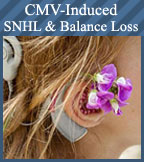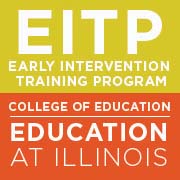Cytomegalovirus (CMV) is the leading cause of infection-related hearing loss, cerebral palsy, mental retardation, autism, birth defects, neurodevelopmental delay, as well as learning disabilities in children living in industrialized countries. Insidious, progressive, and commonly asymptomatic this pathogen infects approximately 44,000 children at birth, or 1 in 150 children – corresponding to 1% of the 44 million babies born with congenital CMV in the in the United States each year.
CMV-Induced Sensorineural Hearing Loss (SNHL) occurs in approximately 50% of children congenital CMV infection. The vestibular end-organ and adjacent cochlea are related anatomically, functionally, neurologically, and pathologically - the virus targets the cochlea, vestibule, & semi-circular canals. Consequently, because the acoustovestibuar nerve also innervates the vestibule (lying adjacent to the cochlea) – responsible for balance, equilibrium & postural control, simultaneous damage to this apparatus by the CMV infection may result in loss of balance & equilibrium in a small grouping of children with CMV-Induced SNHL. The resultant motor delay often initiates a sequence of global delay to other developmental domains for the child aged 0-3, especially with regard to motor output, balance, & equilibrium dysfunction that must be addressed by physical & occupational therapists. Using a case-study approach, this course exemplifies evidence-based practice as an indispensable interdisciplinary approach to the early intervention setting.
Early diagnosis is critical to the child’s success in life as a communicator, because should this hearing loss not be discovered by the time the child reaches a watershed in neurological plasticity – which may range from 24 to 48 months, the child will miss the opportunity to develop receptive hearing - a prerequisite for subsequent expressive speech during a critical neuroplastic time in brain’s development. The 'closing' of this narrow time-related window of opportunity means that the child's ability to speak is forever lost, as they remain mute and are confined to expressively communicate via sign language Early diagnosis and rapid follow up and cochlear implantation is a race against time and a rapidly closing window for this child’s lifelong ability to communicate. In addition to the imperative role of the speech language pathologist and audiologist vis-a-vis hearing & communication, the detection of dysfunction in the child's balance and coordination is essential to the staving off of other developmental delays.
This primer is a MUST READ for all early intervention speech and audiology professionals as well as physical and occupational therapists who service the professional needs of the child with sensorineural hearing loss.
Sign up now!
APPROVED BY THE ILLINOIS EARLY INTERVENTION TRAINING PROGRAM FOR EARLY INTERVENTION CREDENTIAL CREDIT for 4.0 Hours

This program is offered for 0.40 ASHA CEU's (Various Level, Professional Area)
* ASHA LEARNERS PLEASE NOTE: There are two purchase options available to you, EI Continuing Education and ASHA CEU. If you wish to earn ASHA CEUs for this course and you select the CEU option, your information including name, address, e mail and ASHA ID, will be sent to ASHA CE. If you do not want your information sent to ASHA, please select the option for continuing education. Learner must achieve a passing score of 75% on the post course examination in order to meet satisfactory completion requirements.

EITTOC is an AOTA Approved Provider of professional development. Course approval ID# 8922. This distance learning-independent is offered at 0.4 CEUs, introductory, OT service delivery/foundational knowledge. The assignment of AOTA CEUs does not imply endorsement of specific course content, products, or clinical procedures by AOTA or indicate AOTA approval of a certification or other professional recognition.
Meets NY State (NYSOTA) Continuing Compliancy Requirements for continued Core Competency Hours (CCH)
- This activity is pending approval from the National Association of Social Workers (NASW) –
Disclosure: Janisha Verdejo, SLP, has the following relevant financial relationships to disclose: she receives monetary compensation for the preparation of this course, in addition to a percentage of company sales, and has the following relevant non-financial relationships to disclose: EITTOC Board of Directors: volunteer member. Disclosure: David C Saidoff PT - course developer/presenter - has the following relevant financial relationships to disclose: he receives monetary compensation for the preparation of this course, in addition to a percentage of company sales, and has the following relevant non-financial relationships to disclose: EITTOC Board of Directors: volunteer member. Melissa Whelan, OTR - course developer/presenter - , has the following relevant financial relationships to disclose: she receives monetary compensation for the preparation of this course, in addition to a percentage of company sales, and has the following relevant non-financial relationships to disclose: EITTOC Board of Directors: volunteer member. Declaration: Approval of this course does not necessarily imply that any of the governing bodies (e.g., West Virginian Board of Physical Therapy, or other such governmental or NGO’s supports the views of the presenter or sponsor. Information provided should be used within the scope of practice. No relevant financial or non-financial relationships exists between EITTOC or the products discussed any course; no such relationship or endorsement exists for any products mentioned in any courses sponsored by EITTOC, or in any of the items (such as specific AED or Epinephrine injection product) or any testing instrument used to evaluate children; the above course is specific to said-topic, and may not be extrapolated to any other course or topic outside the scope of this course. Course instructor(s) have no other financial or non-financial remuneration - whether prior to or following course delivery; the above advertisement is made available to all physical therapy (and other) licensee on a non-discriminatory basis. Ascend has approved this course and may be contacted about any concerns. Information provided should be used within scope of practice. AOTA does not endorse specific course content, products, or clinical procedures. The onus of responsibility for this course – granted contact hours by the AOTA – is for each OT professional to check with their State board of OT to see if this course meets licensure requirement for continuing education. |







